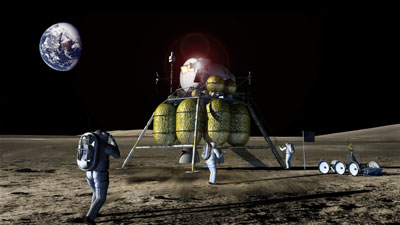How much international cooperation is really needed in space exploration?by Taylor Dinerman
|
| “We cannot go back to the Moon by ourselves,” has become one of those Washington mantras that get repeated over and over without anyone really knowing whether it’s valid or not. |
On the other hand, the ISS was, almost from the start, a US-led international effort. When Space Station Freedom was first proposed by Ronald Reagan in 1984, he and others saw it as yet another way to bolster the West in the struggle against Soviet Communism, and he invited Japan and the Europeans to take major stakes in the project. The offer was enthusiastically accepted by Japan and Italy. In a letter to then Secretary of State George Shultz, NASA administrator Jim Beggs wrote, “The Japanese believe they made a mistake in not joining us on the Shuttle and are determined not to be left behind again. In Europe, Italian Prime Minister Craxi was openly ebullient about the prospect of cooperation and strong Italian participation is assured.” The French and Germans were less enthusiastic but agreed to join the program; Britain gave the impression that they might join on a small-scale basis, but never did.
Without the international imprimatur, the ISS would probably never have survived the early years of the Clinton Administration. Bringing the Russians into the project seemed like a way to cement the new and (then) promising relationship with Moscow. Indeed, the early years of Russian-US joint ventures in space were extremely promising: the shuttle flights to Mir were a great success and taught both sides some valuable lessons.
Russia’s role in the ISS is more complicated. It has created a level of goodwill, confidence, and understanding between the two space organizations that will endure for decades. On the other hand, it has created the problems we all remember from the late 1990s when NASA had to pay, and pay again, for Russian hardware that was in the critical path.
After the Columbia accident, most people involved in the program have said things like, “Thank God for the Russians”. Under current circumstances the Soyuz and Progress vehicles have indeed saved the ISS. If we take a minute and imagine what the alternatives might have been if we had continued with a space station program that kept the Russians at arms length then another picture emerges.
If the ISS had been built without Russia, the US would have had to build a Crew Rescue Vehicle (CRV) to perform the lifeboat and taxi functions now done by the Soyuz. Indeed, the CRV might have been paid for, in part, by the funds that were used to build the Zarya and Zvezda modules. If Russia and the US had decided to go their separate but complementary ways, the Mir station, improved and refurbished, might still be in orbit.
So far the Vision for Space Exploration is closer to the Apollo model than to the ISS one. As in the 1960s, the international scientific community is invited to play a major role in the project. Unlike that era, there are lots on nations that can launch probes up to the Moon. Lunar orbit is going to become quite crowded and the flow of data back down to the Earth is going to be impressive. Turning that information into useful knowledge is not something the US can do on its own.
| A permanent US base on the Moon will give America the overwhelming legal say in what can and cannot be done on the Moon and thus what will happen elsewhere in the solar system. |
Getting human beings back onto the surface of the Moon is going to be an almost entirely US operation. Sure, the Chinese and the Russians may try to beat the US onto the lunar surface, but don’t bet on it. The European Space Agency (ESA) has a small-scale precursor program, but right now and for the foreseeable future, they do not have the funds send people beyond LEO. The Russians, so far, have not been all that receptive to the idea of a genuine partnership with Europe on the Clipper vehicle.
Of all the spacefaring nations, Japan may be best positioned to cooperate with the US Moon program. Their expertise in robot-human interfaces is unmatched anywhere else in the world. A lunar base will need to be built by astronauts and “robonauts” working closely together. Full-scale in situ resource utilization (ISRU) will also require humans and robots to work closely together. Japan is both technically capable of building these systems and may be better able to afford to do so than America’s other potential partners.
The US is probably not going to go back to the Moon as part of an international organization where all the partners are given an equal say, or a veto. Some of the burden and the rewards involved in building an outpost may be shared, and once humans are firmly established up there lunar development will be carried out by people from many nations, but America intends to lead the way.
A permanent US base on the Moon will give America the overwhelming legal say in what can and cannot be done on the Moon and thus what will happen elsewhere in the solar system. Concepts such as homesteading and private property that may be anathema to Europe’s political elites can be firmly established, even in the face of international disapproval. As long as the US maintains its freedom of action it will be able to shape the future economic rules of space commerce to fit both its traditions and its interests. Handing others a veto over future of the solar system is not in the interests of the US, nor in those of other freedom-loving nations.
